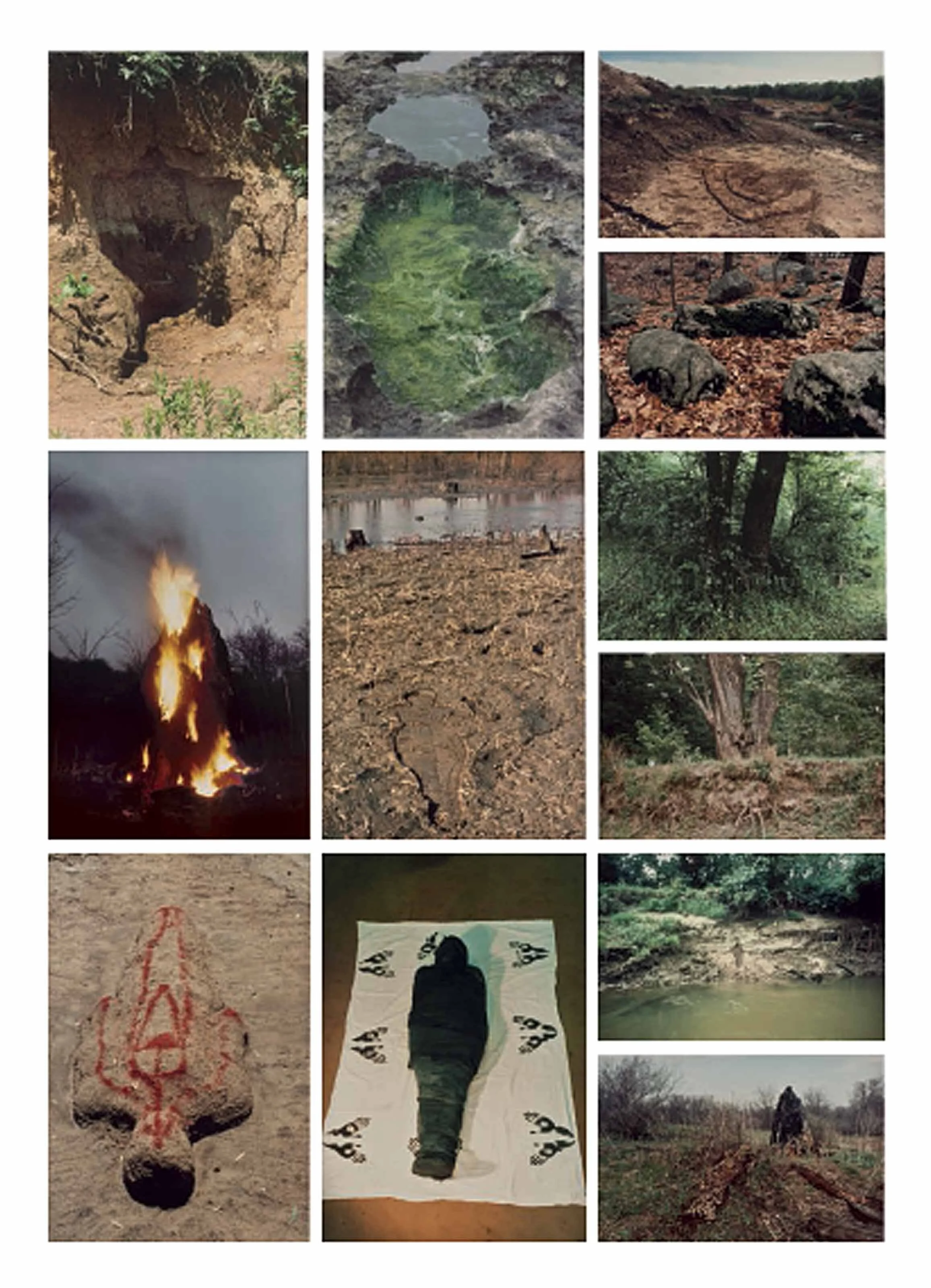Ana Mendieta (American/Cuban, 1948–1985)
Silueta Works in Iowa
1976
photographs
40.6 x 50.8 cm. (16 x 20 in.)
Ana Mendieta - written by Jason Jenn
Like many people, especially those raised in a small rural community in Iowa as I was, my early appreciation of art could be described as conservative, influenced more by Hollywood movies, television, commercial cultural aesthetics, and the more recognizable names of the art establishment before the 1960’s. It was during my studies at the University of Iowa liberal arts college that I became exposed to more conceptual/avant-garde work, but as a theatre and film major my perception of contemporary visual art was still rather narrow. A few touring shows by “big name” performance artists and an understudy class in intermedia arts left me scratching my head and unimpressed by the genre overall. However, that would change through an unusual and unexpected opportunity to take a graduate level course led by Professor Hans Breder, the founder of the University’s Intermedia Program in 1968. His introduction to the “earth-body”/Silueta artworks made in Iowa by Ana Mendieta, his student and dear friend, spoke to me on a profoundly personal level that I recognize as helping propel my journey toward understanding the relevancy, impact and importance that performance and conceptual art can possess beyond more traditional art practices.
Mendieta was a Cuban immigrant, sent to live in Dubuque, Iowa in 1961 at age 12 as part of Operation Peter Pan, a program operated by the US government and Catholic charities to secretly help children escape the Castro regime (her father was a political prisoner of Cuba for 18 years for his involvement in the Bay of Pigs). Likely due to the various language issues she experienced and being bounced around foster homes, she developed a love of art as a means of expression. She received both her BA and MFA from the University of Iowa, becoming fascinated by the local avant-garde community and a fascination with the rolling hills and natural landscapes of Iowa. She developed a strong spiritual connection and relationship with nature that she expressed in her art. Displaced from her homeland, she recognized that creating a tie to the earth wherever she was allowed her to feel whole again.
"Through my earth/body sculptures, I become one with the earth ... I become an extension of nature and nature becomes an extension of my body. This obsessive act of reasserting my ties with the earth is really the reactivation of primeval beliefs ... [in] an omnipresent female force, the after image of being encompassing within the womb, is a manifestation of my thirst for being." 1
Today, Mendieta is recognized as a pioneer in the genres of land art, body art, and performance art - combining them in various ways and documenting the works with photography and film. Natural elements were her primary tools - blood, mud, wood, water, fire. Some of the results may seem obvious today, but were ground-breaking and pushed the envelope during their time and influenced many artists to follow. Some of her works were violent, addressing her concerns with violence towards and the rape of women, particularly in response to the murder of a woman on campus that sent shock waves through the city. In the late 70’s she moved to NYC and joined the Artists In Residence Inc (A.I.R. Gallery), but after a few years helping with the administration of the all-female cooperative gallery, left the group commenting “American Feminsim as it stands is basically a white middle class movement.” 2
Silueta Works in Mexico
1973-1977 (ESTATE PRINT 1991)
It is tragic she died so early in a promising career at the age of 36, when she fell out her apartment window to her death. Some believe the act was perpetrated on purpose by minimal artist Carl Andre, with whom she had a turbulent marriage, but he was later acquitted of the murder charges. Her life was cut short, but her legacy lives on to inspire future generations.
Mendieta is not a household name, but her body of work pervades the art world in various ways and I have been happy to come across various Silueta pieces in several exhibitions in both the US and Europe over the years. Seeing them instantly aligns me to my roots as an Iowan, a performance artist, and a child of the planet Earth, fulfilling her intentions of creating a connection. Examining the various ways in which she create impressions of her body upon the earth, takes on many levels and layers of meaning. Each time I revisit the works, I discover something new - they speak to something different inside me based upon my feelings and experiences of the time. Her documentation presents to the world the remains of a performance - of an act which was intimately created between herself and the natural world. The photo documentation becomes a memorial and a celebration of the way a life lived creates an impression upon the environment. They harken back to primal instincts and as we continue to live so removed and isolated from the earth it becomes so necessary to remind us how the bond comes in many forms. The photos record a ritual, sharing a window into a personal process that becomes universal through its relationship to the cycles of life and death, a reminder where we all came from and will all return.
1 Quote: Ramos, E. Carmen (2014). our america. Smithsonian American Art Museum, Washington, DC.
2 Quote: Butler Schwartz, Cornelia Alexandra (2010). Modern Women: Women Artists at the Museum of Modern Art. New York: The Museum of Modern Art. p. 389.


